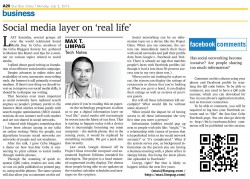THE Agence France Presse (AFP) published an interesting article last week about the use of algorithms to write news articles.
The AFP article, which was written by a human, discussed how a group of new companies use algorithms or mathematical procedures run on computers to turn large volumes of numeric data into articles.
A pioneer in the industry is Narrative Science, which was spun off from a joint research project at the Northwestern University Schools of Engineering and Journalism. The company said its first “automatically generated story” was on a Northwestern Wildcats baseball game.
Narrative Science produces earnings previews for Forbes, turning public data on companies into news articles. Here’s a typical Narrative Science article:
“Analysts expect decreased profit for Gannett (GCI) when the company reports its second quarter results on Monday, July 16, 2012. Although Gannett reported profit of 58 cents a year ago, the consensus estimate calls for earnings per share of 53 cents.
Revenue has fallen in the past four quarters. Revenue declined 2.6% to $1.22 billion in first quarter. The figure fell 5.1% in the fourth quarter of the last fiscal year from the year earlier, dropped 3.5% in third quarter of the last fiscal year from the year-ago quarter and 2.2% in the second quarter of the last fiscal year.”
That news article was produced in less time than you could say “really?” and without a coffee or cigarette break.
Narrative Science also produces recaps of sports events for The Big Ten Network. Here’s a sample article:
“Michael Kidd-Gilchrist scored 24 points and grabbed 10 rebounds to lift Kentucky to a 102-90 win over Indiana on Friday at Georgia Dome in Atlanta in the Sweet 16. Doron Lamb also had a good game for Kentucky (35-2), as he added 21 points, thee [Note: This actually appeared. It’s not a misspelling so the system may have missed it] rebounds and went 6-of-11 from the field. Hot shooting from both sides led to a full-fledged shootout.”
Should journalists worry over losing their jobs to cloud-based algorithmic content producers (utility writing, anyone?)?
Chief executive officer Stuart Frankel told The Atlantic in April, “If a story can be written by a machine from data, it’s going to be. It’s really just a matter of time at this point. But there are so many stories to be told that are not data-driven. That’s what journalists should focus on, right?”
Narrative Science can also turn analytical business data — from earnings reports, stock market data and even news articles – and turn out customized written reports.
The company can also produce personalized reports to students based on their test results. In his blog, chief technology officer Kris Hammond gave a sample report that the system can turn out based on a student’s test scores:
“Math seems to be your strongest area, but you are having particular problems with definite integrals. You should review Chapter 4 in the Math readings and rerun the exercises at the end of the chapter.”
The system can also crunch medical test results and tell people not only what’s ailing them but also give them advice on how to improve their health.
The availability of a reporting layer on top of data is an exciting and transformative field.
It isn’t far-fetched to think that this system will soon interface with personal assistant systems like Siri or the upcoming Google equivalent for Android. Google, which owns Android, is a company built on algorithms and can harness its algorithmic prowess to put up a similar but consumer-focused service.
The post This column is still written by a human appeared first on Leon Kilat : The Cybercafe Experiments.
